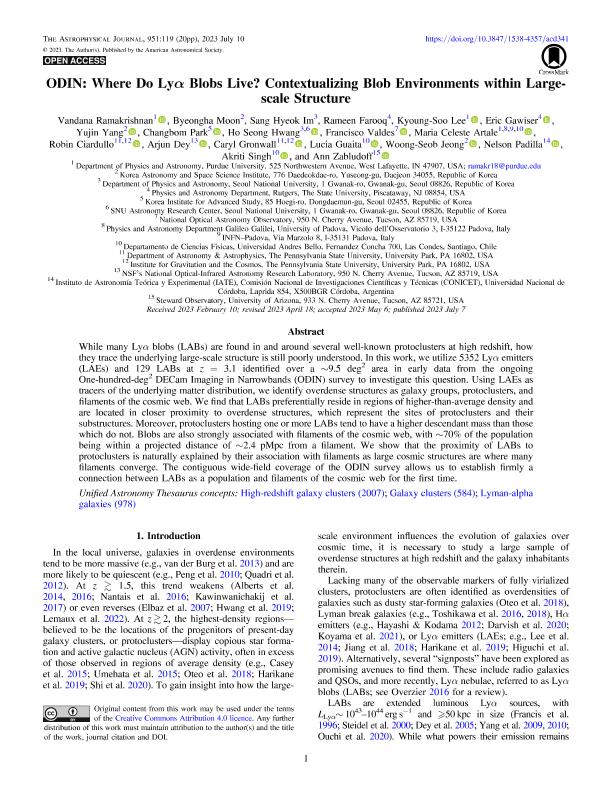Artículo
ODIN: Where Do Lyα Blobs Live?: Contextualizing Blob Environments within Large-scale Structure
Ramakrishnan, Vandana; Moon, Byeongha; Im, Sang Hyeok; Farooq, Rameen; Lee, Kyoung Soo; Gawiser, Eric; Yang, Yujin; Park, Changbom; Hwang, Ho Seong; Valdes, Francisco; Artale, Maria Celeste ; Ciardullo, Robin; Dey, Arjun; Gronwall, Caryl; Guaita, Lucia; Jeong, Woong Seob; Padilla, Nelson David
; Ciardullo, Robin; Dey, Arjun; Gronwall, Caryl; Guaita, Lucia; Jeong, Woong Seob; Padilla, Nelson David ; Singh, Akriti; Zabludoff, Ann
; Singh, Akriti; Zabludoff, Ann
 ; Ciardullo, Robin; Dey, Arjun; Gronwall, Caryl; Guaita, Lucia; Jeong, Woong Seob; Padilla, Nelson David
; Ciardullo, Robin; Dey, Arjun; Gronwall, Caryl; Guaita, Lucia; Jeong, Woong Seob; Padilla, Nelson David ; Singh, Akriti; Zabludoff, Ann
; Singh, Akriti; Zabludoff, Ann
Fecha de publicación:
07/2023
Editorial:
IOP Publishing
Revista:
Astrophysical Journal
ISSN:
0004-637X
e-ISSN:
1538-4357
Idioma:
Inglés
Tipo de recurso:
Artículo publicado
Clasificación temática:
Resumen
While many Lyα blobs (LABs) are found in and around several well-known protoclusters at high redshift, how they trace the underlying large-scale structure is still poorly understood. In this work, we utilize 5352 Lyα emitters (LAEs) and 129 LABs at z = 3.1 identified over a ∼9.5 deg2 area in early data from the ongoing One-hundred-deg2 DECam Imaging in Narrowbands (ODIN) survey to investigate this question. Using LAEs as tracers of the underlying matter distribution, we identify overdense structures as galaxy groups, protoclusters, and filaments of the cosmic web. We find that LABs preferentially reside in regions of higher-than-average density and are located in closer proximity to overdense structures, which represent the sites of protoclusters and their substructures. Moreover, protoclusters hosting one or more LABs tend to have a higher descendant mass than those which do not. Blobs are also strongly associated with filaments of the cosmic web, with ∼70% of the population being within a projected distance of ∼2.4 pMpc from a filament. We show that the proximity of LABs to protoclusters is naturally explained by their association with filaments as large cosmic structures are where many filaments converge. The contiguous wide-field coverage of the ODIN survey allows us to establish firmly a connection between LABs as a population and filaments of the cosmic web for the first time.
Palabras clave:
high-redshift galaxies
,
galaxy clusters
,
lyman-alpha galaxies
Archivos asociados
Licencia
Identificadores
Colecciones
Articulos(IATE)
Articulos de INST.DE ASTRONOMIA TEORICA Y EXPERIMENTAL
Articulos de INST.DE ASTRONOMIA TEORICA Y EXPERIMENTAL
Citación
Ramakrishnan, Vandana; Moon, Byeongha; Im, Sang Hyeok; Farooq, Rameen; Lee, Kyoung Soo; et al.; ODIN: Where Do Lyα Blobs Live?: Contextualizing Blob Environments within Large-scale Structure; IOP Publishing; Astrophysical Journal; 951; 2; 7-2023; 1-20
Compartir
Altmétricas



